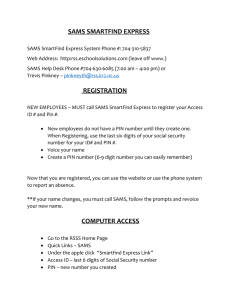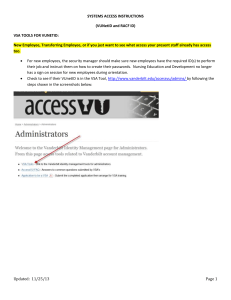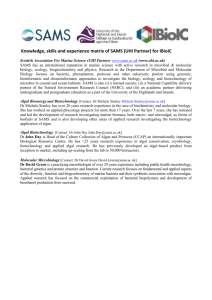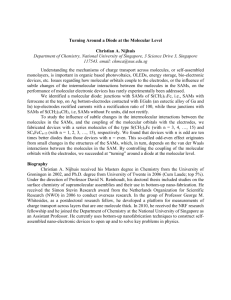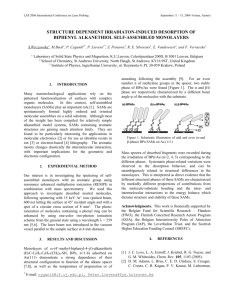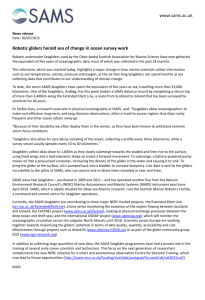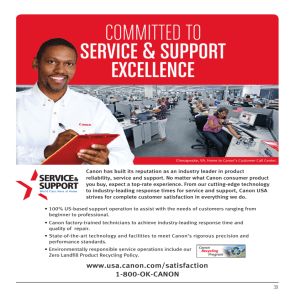SAMS: Strategic Account Management System
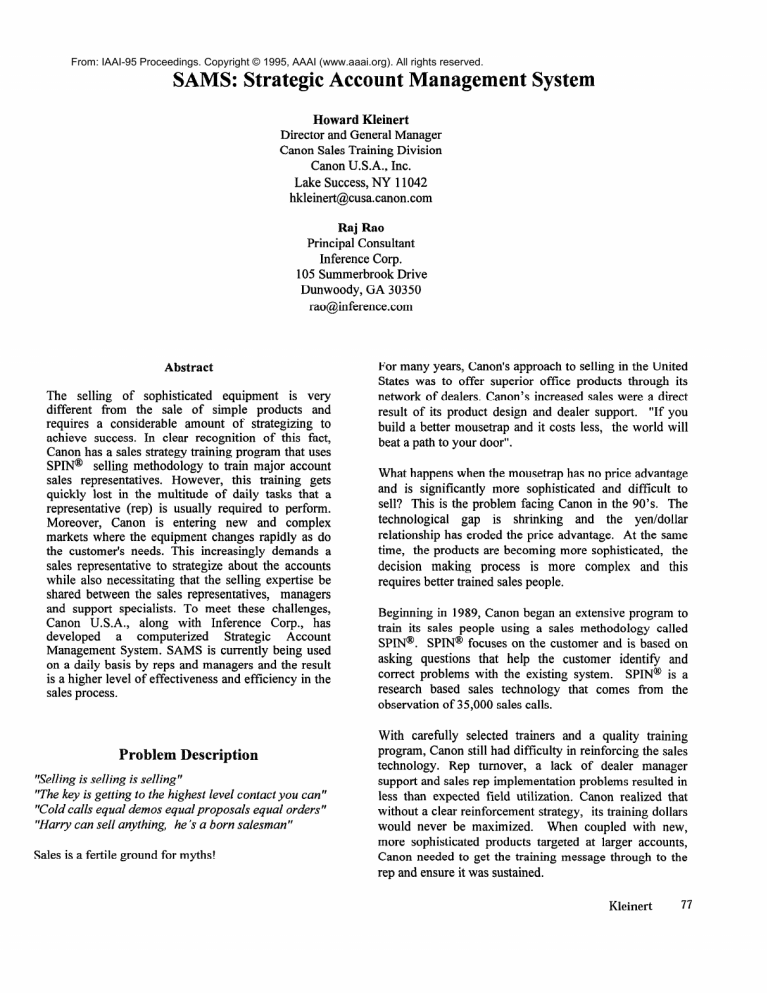
From: IAAI95 Proceedings. Copyright © 1995 , AAAI (www.aaai.org). All rights reserved.
SAMS: Strategic Account Management System
Howard Kleinert
Director and General Manager
Canon Sales Training Division
Canon U.S.A., Inc.
Lake Success, NY 11042 hkleinert@cusa.canon.com
Raj Rao
Principal Consultant
Inference Corp.
105 Summerbrook Drive
Dunwoody, GA 30350 rao@inference.com
Abstract
The selling of sophisticated equipment is very different from the sale of simple products and requires a considerable amount of strategizing to achieve success. In clear recognition of this fact,
Canon has a sales strategy training program that uses
SPIN@ selling methodology to train major account sales representatives. However, this training gets quickly lost in the multitude of daily tasks that a representative (rep) is usually required to perform.
Moreover, Canon is entering new and complex markets where the equipment changes rapidly as do the customer’s needs. This increasingly demands a sales representative to strategize about the accounts while also necessitating that the selling expertise be shared between the sales representatives, managers and support specialists. To meet these challenges,
Canon U.S.A., along with Inference Corp., has developed a computerized Strategic Account
Management System. SAMS is currently being used on a daily basis by reps and managers and the result is a higher level of effectiveness and efficiency in the sales process.
Problem Description
“Selling is selling is selling”
“The key is getting to the highest level contact you can”
“Cold calls equal demos equal proposals equal orders”
“Harry can sell anything, he ‘s a born salesman”
Sales is a fertile ground for myths!
For many years, Canon’s approach to selling in the United
States was to offer superior office products through its network of dealers. Canon’s increased sales were a direct result of its product design and dealer support. “If you build a better mousetrap and it costs less, the world will beat a path to your door”.
What happens when the mousetrap has no price advantage and is significantly more sophisticated and difficult to sell? This is the problem facing Canon in the 90’s. The technological gap is shrinking and the yen/dollar relationship has eroded the price advantage. At the same time, the products are becoming more sophisticated, the decision making process is more complex and this requires better trained sales people.
Beginning in 1989, Canon began an extensive program to train its sales people using a sales methodology called
SPIN? SPIN@ fo cuses on the customer and is based on asking questions that help the customer identify and correct problems with the existing system. SPIN@ is a research based sales technology that comes from the observation of 35,000 sales calls.
With carefully selected trainers and a quality training program, Canon still had difficulty in reinforcing the sales technology. Rep turnover, a lack of dealer manager support and sales rep implementation problems resulted in less than expected field utilization. Canon realized that without a clear reinforcement strategy, its training dollars would never be maximized. When coupled with new, more sophisticated products targeted at larger accounts,
Canon needed to get the training message through to the rep and ensure it was sustained.
Kleinert 77
Canon also recognized that one of the biggest impediments to effective planning and strategizing was that a substantial part of a sales representatives time is consumed in organizing and managing information and doing other routine tasks such as producing reports for managers. Sales reps frequently suffered from information overload.
With Canon expanding into newly created markets such as color copiers and networked copiers, sales representatives are now required to have information and selling expertise in multiple and varied areas such as computer networking.
It is becoming increasingly difficult for one person to have the expertise in all the required areas. This problem is further compounded by the fact that a sales representative often has to work alone with little or no feedback about the progress of the sale. designed to be used by sales representatives, managers, from all these organizations. and their
What does SAMS do?
SAMS has multiple roles - it is an advisor, a strategic guide, and a personal information manager. It guides the user through the recommended steps at every point of the sales cycle in order to maximize effectiveness. Moreover, when a sales representative faces a problem during the sales cycle, SAMS may be used to recount similar cases from past experience to try to find a solution to the problem. In addition, it provides efficiency enhancing tools that aid the sales representative in performing routine tasks, such as letter generation, in a manner that is faster, better and more consistent .
Objectives of the application
Considering the problems with the existing mode of operation, Canon recognized that a system needed to be developed that would achieve the following objectives:
* preserve Canon’s training investment by constant reinforcement of key concepts;
0 distribute strategic and tactical selling expertise;
0 enhance sales effectiveness by providing tools that induce strategic thinking; e improve efficiency by organizing and automating several routine activities.
In addition, the application has the secondary objectives of familiarizing sales representatives with emerging computer technologies and also improving communication between a representative and his manager by providing a common framework and terminology for meaningful dialog. This “team behavior” becomes increasingly more important as larger accounts with more complex decision making structures are targeted.
Application Description
Who uses SAMS?
Canon has a large distribution network selling office equipment comprising of approximately 500 dealers, 5 subsidiaries and 60 National Account sales reps. SAMS is
How does SAMS do it?
SAMS accomplishes its objectives by providing a wide array of tools (discussed in the section “SAMS functionality”). These tools range from simple information organizing tools to strategic tools designed to induce and promote long term thinking in the sales representative.
With several tools to choose from, there is a potential danger of the appropriate tool getting lost among the others from the user’s perspective. SAMS avoids this by presenting the right tool at the right time, by means of good user-interface design and by proactively presenting tools when needed. For example, when setting up a call, the user is prompted for the type of call. If the call type is
Presentation, then the option to view expert advice on how to give a quality presentation under the current account circumstances is proactively offered.
SAMS functionality
For SAMS to achieve the wide variety of objectives that had been set out, clearly it had to bundle a large array of tools.
The tools provided by SAMS may be broadly categorized as:
0 Account Information Management e Activity Management
0 Strategic Coaching and Brainstorming e Strategic tools
0 Efficiency Enhancement tools
The figure below is a simplified schematic representation of the different modules and indicates the navigational sequence among them. These tools are discussed below.
78 IAAI-95
Calendar
7
Brainstorm
Objectives Analysis
Equipment Profile
ii;‘...
Contact Profile
---cI Transaction Profile
Rolodex Word Templates
Navigation among SAMS Tools
Kleinert 79
Account Information Management
SAMS stores important account information such as profiles of accounts, corporations, contacts in an account, current transactions occurring in an account, equipment inventory in an account, etc. An example of one such screen is shown here.
R-o Headquaters
Smart Reminder Screen
Account Profile Screen
Activity Management
Typically, a sales rep has to deal with many tasks in a day.
These might range from making important customer presentations to routine copier toner delivery. Activity
Management tools aid the sales representative in planning and executing these activities in a manner that maximizes sales effectiveness.
A key module that aids in the management of activity is the Smart Reminder. This not only performs the usual tasks of a reminder list such as alerting the user if there are any “to-dos” for the day, but it also scours the database and analyses account information to come up with suggestions on what should be done. For example, if certain changes to a competitor’s marketing direction are discovered during specific stages of the sales cycle, SAABS may suggest usage of the Vulnerability Analysis tool against the competitor to assess the impact of the changes and provide possible strategies.
Other tools that help manage activities include
8 Call Setup -- assists the sales representative in setting up and planning strategically focused calls
0 Call Review -- reviews a call with the representative after the call has been made and allows the rep to enter call outcomes, think about lessons learned and to strategize about future actions e Calendar -- to schedule to calls that need to be made, and
Q Activity Histoly Tracking -- presents a chronological list of calls that have been made to an account or contact.
As an example, the Call Setup Screen is shown below.
Call Setup Screen
80 IAAI-95
SAMS Advisor -- Strategic Coaching and
Brainstorming
The primary objective of SAMS is to provide guidance to the user where and when necessary. The sales manager would be the likely resource for the rep. Unfortunately, the manager may not have the expertise to provide guidance in these new emerging markets or may be unavailable. Support would be welcome when the sales representative is faced with a problem and would like some options to evaluate and choose from. Coaching may also be needed to help the sales representative strategize about an account. The SAAB Advisor, a collection of cases, provides this guidance.
SAMS uses case based reasoning technology to implement the Advisor. Knowledge is embedded in the Advisor in the form of cases. These cases not only encapsulate the strategic methodology, but they also incorporate valuable lessons learned from real life experiences of sales reps.
Broadly, the Advisor can with: be used to provide guidance
0
Problem solving
8 Strategizing about account objectives
8 Planning presentations and call advances d Determining account parameters such as the account buying phase, account priority, etc. e Countering competitive vulnerabilities and analyzing issues of consequence to a customer
Determining the next step in an account
Cases are authored using CBR Express and retrieved from
SAMS using CasePoint (provided by Inference Corp.). To use the Advisor, a sales rep types in a natural language description of the situation/problem. At this point, the
Advisor prompts the user with pertinent questions based on the entered description. Each user response to a question narrows the field of relevant cases in the case base, potentially resulting in a new set of questions being prompted. The user iteratively answers these questions until the best matching case is retrieved. The ‘action’ associated with this case provides the solution to the user’s problem/situation. Many of the actions in the Advisor are implemented as hypertext.
At various points in the SAMS application, a user finds the “Advice” button which when activated brings up the
Advisor and automatically pre-answers classification questions thereby allowing the relevant section of the
Advisor to be easily accessed. In addition, while using the
Advisor, questions that may be answered based on the information available in the SAMS database are done so automatically by SAMS.
Strategic Tools
While almost all the modules in SAMS have a strategic orientation with regard to the type of information that they ask the user to gather, there are two tools in particular that may be termed as strategic tools. They are used to perform: e Objectives Analysis, and
@ Vulnerability Analysis.
Typically in an account, several transactions involving different types of equipment may be going on simultaneously. In order to effectively strategize about the entire account, one needs to keep sight of the larger picture. The Objectives Analysis tool provided in SAMS induces the sales representative to step back from their hectic day-to-day activities to get a global view of the account.
The rep starts by establishing an account goal and then outlines the objectives that will help him achieve that goal.
Problems in achieving each individual objective are identified and specific action items for each problem are entered. This comprehensive exercise helps the reps to focus on the daily actions needed to achieve their account goals.
Objectives Analysis Screen
The Vulnerability Analysis tool allows a sales representative to identify his strengths and weaknesses in comparison to the competitors. This requires a thorough understanding of the customer’s decision criteria -- the criteria on which they will be basing their purchase decision. Following this, the rep determines how the
Kleinert 8 1
customer views Canon with respect to the competitor on these criteria. This is performed in SAMS in the
Vulnerability Analysis Input screen shown below.
Vulnerability Analysis -- Input
Following input of this information, SAMS may be asked to analyze the situation. This brings up the Vulnerability
Analysis Assessment screen as shown below. In this,
SAMS analyzes the strengths and weaknesses and displays its assessment of the situation in fuzzy terms.
Vulnerability Analysis -- SAMS Assessment
If advice is required on how to counter an identified vulnerability, like in other screens, the Advice button may be activated which invokes the SAMS Advisor. Strategic and experiential advice pertinent to the specific decision criteria and vulnerability type is provided by the Advisor at that point. An example of the Advisor screen initiated from the vulnerability analysis screen is shown below.
82 IAAI-95
Select the strategy you’d like to erplore.
What type of guidance do you seek with Vulnerability
What type of gap is present? m Is the gap significant enough to address?
Analysis?
Vulnerability interpreting analysis a gap
Vulnerability Analysis -- SAMS Advisor Help
These strategic tools help in identifying potential weaknesses within an account. They assist the rep in formulating successful strategies to counter competitive strengths in product, service or marketing. Additionally, they help the rep to elevate or highlight areas of Canon strength that exceed the competition and enable the rep to bring them to the attention of the prospect in a strategic way. Elevating incidental decision guidelines is a subtle yet successful strategy that sophisticated sellers use and integrate into their daily activities. SAMS helps users systematically recognize these opportunities and promote them to the prospect.
Efficiency Enhancement Tools
These include:
@ Automatic letter generation -- retrieves necessary information from the database and generates letters based on templates that have been developed in Microsoft
Word
@ Sales forecasting -- uses information entered about on-going transactions and automatically creates forecast reports
0 Word processor
0 Cardfile, calculator and other Windows applets e Sales tracking -- allows a rep to input sales targets and graphically displays them against the actual sales and commissions figures that are computed using data gathered during call reviews. An example of this screen is shown below.
SAMS Architecture
With the target audience being sales representatives who frequently have to travel from account to account, the deployment platform would have to be portable computer.
Canon decided to use Intel based laptop computers as the deployment platform.
Keeping in mind that a very important business requirement of the system is a high level of ease of use,
Microsoft Windows was chosen as the environment to develop a point-and-click interface for SAMS. However, some sales representatives in Canon already have
Macintosh computers and a decision was made early on to design the system in a manner that would allow the application to port easily to the Macintosh computers if the need arose. In view of this constraint, an application development tool that allows deployment across multiple platforms was sought. Art*Enterprise (provided by
Inference Corp.), in addition to providing the basic infrastructure and paradigm for the development of expert systems and object-oriented applications, promised to ease migration across multiple platforms and was chosen as the main development tool.
Moreover, for SAMS to perform its various roles of advisor, information manager and a training reinforcement tool, it had to include a number of other components.
These utilize software packages such as CasePoint,
Art*Enterprise(A*E), Microsoft Word, a custom-built calendar, Windows hypertext, dBase database and
Windows applets as shown below.
Kleinert 83
Jlicrosoft Windows 3.1
Windows
Applets
MS Word
Letter Templates
C++ Custom App
Hypertext
Actions
Sofiare Environment
These software packages are integrated together using a variety of techniques such as dynamic data exchange
(DDE), dynamic link libraries (DLLs), and the Windows clipboard in conjunction with the Windows Recorder application.
SAMS encourages communication between the sales rep and his manager. Rep/manager collaboration was a critical design element of the system. Allowing the manager to be the focal point for information transfer would enable the manager to gain insight from all of the reps on the team.
This would enhance everyone’s knowledge and experience concurrently. This is done in a large part by providing tools that are best utilized by having them team up. To allow this, SAMS data can be exported from the sales representative’s database and imported into a manager’s system. This also allows the manager to have the information of all the representatives right in his computer and to generate reports.
AI techniques used
SAMS uses frame-based design and object-oriented programming techniques to achieve separation between the user interface layer, the domain knowledge layer and the database layer. A simplified diagram illustrating the object classes is shown below.
84 IAAI-95
Objects and has-a relation denoted by arrows
Domain knowledge is embedded in the form of methods attached to objects. This knowledge is used to provide two functions: e knowledge-based validation and e knowledge-based suggestion.
Knowledge-based validation involves checking to see that the pieces of information that have been entered do not violate any hard or soft constraint or sales guideline. For example, if a sales rep has set up a call indicating a presentation to the decision maker, SAMS determines if prerequisite calls have been made at other levels of the organization first in the absence of which SAMS warns of this violation and presents the dangers inherent in this action.
Knowledge-based prompting suggestion involves identifying for future action based on changes to information. For example, when a customer goes into a buying phase called the “Resolution of Concerns”, SAMS may prompt the user to utilize a tool to analyze consequence issues at this stage. and
In addition, SAMS uses CBR technology to store and retrieve relatively unstructured information. The nature of sales expertise makes CBR technology particularly suitable for the task of advising. Sales expertise is contained in the case-base in two forms: first as case studies or “war stories” and second as strategi6 methodology guidance, or textbook knowledge. In addition, the case actions are largely in hypertext format.
With this feature, not only can the user enter a text description of the current situation and access the appropriate section of the strategic framework but also be
Kleinert 85
able to access other related and when necessary. sections through hypertext as
Many of the classification questions in CasePoint are automatically answered when invoked from the “Advice” button. Moreover, questions that may be answered either directly from the data in the database or computed from this data are done so whenever possible from SAMS. An interesting observation that has been made by the users of
SAMS is that the questions that are asked by the Advisor in order to fmd the best matching case were in themselves a good form of guidance in that they pointed to the type of information that the rep should be gathering from the customer for effective formulation of strategy.
Knowledge Acquisition
Like experts in other fields, sales experts find it very difficult to articulate what specifically makes them successful. Moreover, lot of subjective personality traits are described as being the key ingredients of successful selling. The knowledge engineer is entrusted with the additional task of distilling from the narrated experiences those aspects that are more generic in application.
To perform knowledge acquisition, an Executive
Committee was created consisting mainly of experts in the sales strategy as well as experienced and successful sales representatives. This committee met regularly to determine best practices cases. In addition, because the availability of the members of this committee was limited, a three tier strategy was adopted. The Executive
Committee identified Knowledge Directors who were expert in particular areas of strategic planning, and the
Knowledge Directors in turn identified the most expert
Sales Representatives. This way, knowledge from varied levels of expertise and field experience was available.
Knowledge acquisition was performed over a period of one year primarily with one knowledge engineer dedicated to this task. The knowledge sources were geographically distributed and more than half of the knowledge acquisition was done using structured interviewing techniques over the phone. However, before performing telephone interviews, it was very important to meet all the knowledge sources in person and develop good rapport with them. At the initial meetings, usage of the Affinity
Diagramming technique to elicit knowledge, where the expert uses free association on a topic followed by categorization and identification of relations among the categories, was found to be very useful.
Knowledge validation was performed on a regular basis by the Executive Committee. This was done by actually viewing the case-base one case at a time and ensuring that none of the knowledge was conflicting with the basic tenets of the strategic methodology adopted by Canon.
Application Uniqueness and Innovation
The Strategic Account Management System is unlike any other sales force automation tools which focus on improving sales rep efficiency -- SAMS targets sales rep efictiveness. SAMS doesn’t just track activities, it helps the rep make the most of every account and every sales call. SAMS helps the rep to strategically think about his account and prepare for a successful sales call while focusing on the correct account goals and objectives.
SAMS reinforces the training messages that exist through
Canon’s training programs and literature while suggesting alternatives in account management strategies. These strategies are consistent with the training message and are based upon best practices research from a variety of sources.
Additionally, SAMS does the usual sales force automation tool functions that reps need every day. It has reminder lists; it tells the user when an equipment contract expires; it has a rolodex; it assists with income planning; and it provides all of the other tools that reps need for success.
For example, scanned in images of Canon product and competitive specs eliminate the need to carry heavy manuals or reference materials. SAMS can generate customized letters for follow up such as thank you memos or proposals. These tools are smoothly integrated into the strategic framework and are employed to efficiently execute strategies that are generated by the user working with SAMS.
To the best of our knowledge, SAMS is the only sales automation tool that actively embodies and uses strategic knowledge and expert knowledge as an integral part of its function. It is primarily this knowledge orientation that enables it to enhance the effectiveness of a sales rep.
Project History
Application History
The Director and General Manager of Sales Training for
Canon discussed the idea of a sales force automation tool that would support major account sales with Huthwaite
(Canon’s sales strategy training vendor and developers of the SPIN methodology). After some investigation,
86 IAAI-95
Inference Corporation presented some options and gave
Canon and Huthwaite a demonstration. Skepticism was everywhere. How would we gather the data to enter in the case base? How could we get the dealers to use the system? How could we persuade successful sales reps to use the system. 3 How would we train these sales reps to use computers?
Concerns were reinforced when sales reps were unable to articulate the reasons for their success. Research shows that when asked, sales people do not understand the behaviors they portray while doing what they do.
Conventional sales wisdom (e.g., closing and objection handling) become the main reasons reps mention when it is recognized through research that other skills lead customers to buy.
Canon came very close to canceling the project after the initial sales rep interviews. The reps’ inability to articulate their experiences was forcing Canon to rely on the
Huthwaite information vs. actual sales rep encounters.
This imbalance in the case-base was felt to be counter productive and would lead to a “sterile” approach to solutions by the users.
The solution was a group of Canon employees and vendors that became the Executive Committee as was discussed above. The committee met five times to gather the foundation for the case-base. With highly focused questioning and discussion, behaviors were codified and recorded. These were added to cases developed by trainers and field reps. They are grounded in the fundamental training methodologies found within
Huthwaite’s training and the sales experiences of the
Executive Committee.
The development of SAMS first started with a quickly implemented conceptual prototype that was developed in
December 1992. This prototype acted as a tool to not only get Canon to understand and gain familiarity with the various components of the system, but also as a tool for
Inference to fully work out the system requirements with
Canon. After the acceptance of the prototype, the SAMS application development was undertaken. No code from the initial prototype was reused in SAMS. However, the prototype was not discarded. Even after the application development had started, the prototype was shown to other Canon dealerships in order to generate buy-in as well as to confm that the requirements from all users in the field would be met by SAMS.
Following the initial prototype, the SAMS application entailed development efforts of approximately 28 person- months. Of this, roughly 9 person-months went into gathering and creation of cases.
Project cost and justification
Canon knew the cost for the total project would exceed one million dollars. How could Canon justify this expense and what would the ROI be and when could break even be achieved?
Surprisingly, these questions were not of primary importance. The Director and General Manager for the
Copier Division funded the project because he knew the issues were long term success and major account penetration. With Canon’s products evolving into networked printing solutions, how could Canon ever expect to enter the major account arena with the sales force at its current level. Canon needed some intervention that could dramatically alter the way its dealer reps handled these accounts.
Canon believed that the strategic implications and benefits for its dealers far outweighed the financial risk. What could be more damaging than having leading edge products designed to meet the integrated office needs of complex customers without sales people effective in selling products of this type ? How many times have any one of us encountered a sales person who was incapable of understanding what we needed but who could recite chapter and verse on the company’s product? To be competitive in the future, sales reps had to become more effective, and an automated sales tool was the method
Canon chose to implement this strategy.
Deployment Process
As mentioned previously, Canon uses a dealer based distribution network. Dealer reps are trained at their dealerships or at Canon sites in groups of ten or less. The training is conducted by Canon Sales Training Specialists.
These instructors are well versed in the Huthwaite training technologies and were cross trained into SAMS,
Microsoft Windows and Word.
BE Associates was hired to handle all of the details for the training sessions that would be conducted. They created the instructor guides for the Canon trainers as well as the student materials. They also observed the initial deliveries of the beta training classes to record the outcomes and integrate knowledge learned into the revised instructor guides.
Kleinert 87
Prior to training, the students are sent an extensive letter outlining the training and prerequisites required for participation Canon has bundled the SAMS program with certificates from Executrain. This outside training company has locations throughout the United States and is responsible for providing Windows and Word instruction in their facilities. With this prior knowledge, students are trained on SAMS in a three day period.
Application Use
Initial testing of SAMS involved verification and validation of all the components of the system by the
Executive Committee and was conducted in August 1993.
Following the acceptance of the system, an implementation plan to launch SAMS was put in place.
The deployment plan of the application called for launching to be conducted over a period of time in phases in order to ascertain that each and every user would receive the proper training in the usage of computers and
SAMS.
The first release was put into production on November 9,
1993. In the fust release, the system was distributed nationwide to selected Canon National Account executives and account managers. In the second release conducted in
December 1993, more National Account executives have been included in the program. Additional releases have occurred throughout 1994. At the time of this writing, over 50 systems are in use on a daily basis.
Application Maintenance
Canon believes strongly that a key element of SAMS future success will be the creation of a “core elite”.
SAMS users should form a fraternity of reps that will be the foundation for knowledge transfer to newly hired reps at the dealer level.
To make this a reality, Canon solicits highlights of key successes and failures experienced by the reps.
Experiences deemed to be of generic and significant use to the rest of the reps are converted into cases and included in the case-base.
The SAMS case-base contains approximately 500 cases.
Canon anticipates that this case-base will continue to evolve and expand over time. These cases are added by the Case-base Administrator who is a writer within the
Sales Training Division. The individual is totally familiar with Canon training programs and equipment. Canon has
88 IAAI-95 made a commitment to keeping SAMS relevant and updated. Selling is not a “static” environment. SAMS must change and grow to continue to be effective, and processes have been introduced to ensure this happens.
SAMS is specifically designed to evolve. This evolution may not only occur in the knowledge contained in the case-base, but also in the form of more complex information management requirements. This is realized fustly by using object oriented methodology for program development and secondly by having a very modular design in terms of the components of the system. For instance, when Canon decided to incorporate a calendar with better functionality, this task simply entailed building and plugging in a new calendar application using the integration hooks in SAMS.
Additionally, CBR Express is the authoring tool that is used to maintain the knowledge embodied in the case- base. Since this tool does not require any sophisticated programming knowledge to use, Canon can maintain and update the casebase in-house.
plication Payoff
Unlike other applications of AI technology where a singular conclusion is appropriate and desired, sales success may be determined by the implementation of multiple strategies. Sales success in major accounts demands flexible thinking and strategic planning. The strategic orientation of SAMS, by its very nature, makes estimation of the short-term benefits in terms of hard numbers difficult, if not impossible.
Nevertheless, it is clear that SAMS has already had many substantial benefits. We summarize some of these benefits as follows:
1. SAMS focuses the sales process and provides structure and discipline to sales activities. The selling environment is hectic and often times chaotic! SAMS provides the reps an alternative to “winging it” by adding discipline and direction to each sales activity. While managers are often too busy to provide strategic selling support, SAMS fills that role by becoming an interactive partner in the sales process.
2. SAAB adds consistency to all sales calls. SAMS demands that reps prepare more carefully for their critical calls. This has avoided repeat calls and improved each customer contact. Reps are now developing account
strategies in a more uniform way. Critical items are never ignored or forgotten.
3. SAMS’ helps reps recognize and prioritize sales opportunities. With competitive equipment inventories in the system, reps are notified in advance of contract expirations. This insures that some focus is placed on these competitive units and customers are duly contacted.
Reps also use the Advisor to prioritize multiple opportunities.
4. SAMS also provides features that make the whole sales process easier. No longer do sales reps need to know the exact specifications and pricing for dozens of different copiers or configurations. Nor do they need to know the details of the multitude of competitive units. They simply look up the equipment specifications in SAMS. Salesmen are always on the run. SAMS offers a Rolodex and calendar application to provide seamless support to the rep on the go. With countless phone calls, appointments and presentations, SAMS provides a sense of security with
“to do” and reminder capability.
5. SAMS has reduced the cost of rep turn-over. From the dealer’s perspective, SAMS offers a chronological history of events. Sales managers can review calls made to key accounts both in terms of quantity and quality. Many times, sales people pursue career opportunities elsewhere.
With SAMS, every call, every contact, every piece of equipment and all strategy sessions are recorded for the new rep or manager to evaluate. This means that quality customer support will be uninterrupted and maintained.
6. Because SAM heavily supports Canon Sales Training programs, Canon knows that its message is being reinforced by each SAMS user. Having a common language that can be shared by Canon’s dealers and sales people will have significant impact. Additionally, Canon
National Account sales people can now discuss key accounts with dealer reps and share information in a uniform, consistent manner.
7. SAM5 has created a better “team” atmosphere. While difficult to measure, there have been closer ties and communication between Canon and the dealers due to mutual support and involvement. addition to being a personal information manager. SAMS uses CBR technology to encapsulate knowledge in the form of cases. SAMS has been successfully implemented and is currently being used on a daily basis by reps and managers.
Acknowledgments
We would like to acknowledge the significant effort afforded by Ed Topar, Mitch Bar-dwell, Dick Ruff, and other members of the SAMS Executive Committee; Gay
Bar-field, Robbie Tremblay, Lisa Zoba, Al Winn and other
Knowledge Directors; and all the sales representatives who took the time to talk to us and impart the knowledge that today resides in SAMS. We also would like to thank
Alec Berenbaum and Amy Rice without whose diligent and devoted efforts SAMS would not have been finalized.
We would also like to thank Mrs. Rao and Mrs. Kleinert who spent countless hours alone while we worked on this project. They are the unheralded supporters of this project who may go unnoticed in the context of this report but not in the hearts of the authors.
Trademark Ac
SPIN is a registered trademark of Huthwaite Inc.
CasePoint and CBR Express are registered trademarks of
Inference Corp.
Microsoft is
Corporation. a registered trademark of Microsoft
Microsoft Windows and Microsoft Word for Windows are trademarks of Microsoft Corporation.
Summary
SAMS, Canon’s Strategic Account Management System, is the first sales automation tool that embodies expert knowledge. It serves as an assistant to the sales rep in
Kleinert 89
